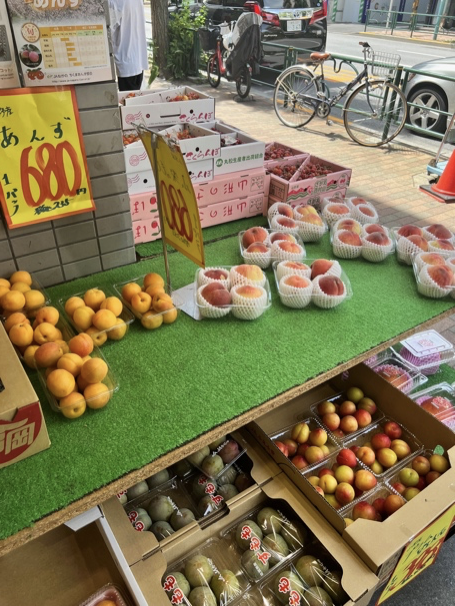From tourist to resident: Navigating food in Japan’s restaurants and supermarkets


Written by
Name: Andra
Country of origin: Romania
How long you’ve lived in Japan: Fully in Japan since Feb 2023 (resident since Sept 2022)
Where you live in Japan: Tokyo
Instagram
When I first visited Japan as a tourist, I thought I knew what to expect when it came to food. Japan is famous for its sushi, ramen, and delicious street food, and eating out was one of the highlights of my trip. However, when I moved to Japan to live, I quickly realized that dining and grocery shopping are a whole different experience. As a tourist, it’s easy to enjoy Japan’s food scene, with its menus in English, pictures on signs, and staff who speaks some level of English. But living here, especially as a newcomer who doesn’t speak Japanese, food can become both an adventure and a challenge. From figuring out how to order food in restaurants to standing in front of supermarket shelves, unsure of what to buy or where to find it, the learning curve can be steep.
This article will take you through the differences between visiting Japan as a tourist and moving here to live, all through the lens of food. I’ll share personal stories of the challenges I faced and how I slowly learned the “dos and don’ts” of eating and grocery shopping in Japan. If you’re planning to move here or just curious about how daily life is different from tourism, this article will help you understand what it’s really like when you’re in it for the long haul.
The tourist experience: Dining out in Japan
As a tourist, Japan’s food scene feels like an endless buffet of deliciousness. I remember the first time I visited Japan—I was on a food tour, happily wandering the streets of Tokyo, eating sushi and exploring all sorts of food at every opportunity. Restaurants are set up for tourists, especially in big cities like Tokyo and Kyoto, where most places offer English menus or have pictures on their menus to help you decide what to order. Even if there’s a language barrier, it’s easy to get by.
One of my first favorite experiences was visiting a sushi belt restaurant, where plates of fresh sushi and sashimi pass by on a conveyor belt, and all you have to do is grab the ones you want. I didn’t need to know much Japanese; I just picked up the sushi I wanted and ate it. The fish was surprisingly fresh, and the staff were so polite, it made dining feel special and easy, even if it was just a casual meal.

But what I remember most about my tourist experience was the lack of concern over how food got to the table. I didn’t need to think about ingredients, cooking, or the logistics of getting groceries. I could just enjoy my food and focus on the experience. For tourists, the food is part of the adventure. This makes it easy to enjoy Japan’s cuisine.
The reality of living in Japan: Grocery shopping and cooking at home
When I moved to Japan, I thought I’d be able to continue enjoying the same food experiences I had as a tourist. But as a resident, things were different. The first big challenge I encountered was grocery shopping. I had to figure out where to buy food at convenient prices, how to navigate the labels, and how to deal with the language barrier in supermarkets.

On my very first day living in Japan, I thought I could easily pop into a supermarket and grab everything I needed to make a simple dinner. I needed veggies, olive oil, some meat and some fruits. I remember I specifically wanted to buy pomegranates to make a salad. I figured it would be pretty straightforward. It wasn’t.
I went to two different supermarkets in my neighborhood, each time finding that they didn’t have what I was looking for, or at least, not in a way I understood. At the first store, I couldn’t find all the ingredients I needed and couldn’t pay because they would only accept cash. I later learned that many local supermarkets tend to avoid the use of credit cards. At the same time, at least where I lived, Apple Pay was almost never accepted. At the second store, I thought I found everything I needed after spending one hour trying to read the labels written entirely in Japanese. I guess I will never actually know because I never managed to pay there either. In my frustration, I decided to buy some pre-cooked food from the convenience store and call it a day.
Initially, I didn’t realize that even simple ingredients could be tricky to find. For example, the bread I was looking for wasn’t like the loaves I was used to; it was soft and sweet, and not good for making a sandwich in my opinion. The milk was in a carton with no obvious indication of whether it was fresh or UHT (long-life). All yoghurts were sweet. The learning curve was steep, and suddenly, cooking at home felt like a much bigger task than I had imagined.
Convenience stores vs. supermarkets: What’s the difference?
One of the first things I learned about living in Japan was the importance of convenience stores. Konbinis like 7-Eleven, Lawson, and FamilyMart are everywhere, and they offer an incredible selection of food. From onigiri (rice balls) to hot meals, snacks, drinks, and even desserts, you can find almost anything you need for a quick bite. They even have freshly made sandwiches, bento boxes, and hot fried chicken.
But for a resident who wants to cook at home, these stores are useful for convenience but not practical for stocking a kitchen with fresh ingredients. The food at convenience stores is often pre-packaged and ready to eat, but they lack the range of raw ingredients and cooking staples found in a supermarket.
Supermarkets in Japan are larger and offer more variety, from fresh produce to packaged goods, meats, and seafood. However, supermarkets are also much more overwhelming for someone who doesn’t read Japanese. When you walk down the aisles, there are hundreds of different products, and it’s not always clear what they are. Even everyday items like soy sauce or cooking oil can come in several different types, all labeled in kanji, and it’s easy to pick the wrong one if you’re not careful.
Expensive vs. cheap supermarkets: How to shop smart
In Japan, there’s a big difference between expensive supermarkets and budget-friendly ones. In the beginning, I made the mistake of going to high-end supermarkets like Isetan or Mitsukoshi, thinking I would find the best-quality ingredients. While these stores carry premium products, they are also very expensive. A single apple at Isetan could cost as much as ¥400 ~ $3, and a small package of meat could cost twice as much as in other supermarkets.
After some trial and error, I discovered cheaper supermarkets. OK Supermarkets offer a wide range of affordable, everyday groceries, including fresh produce, meats, seafood, snacks, and ready-made meals. Summit Supermarkets focus on higher-quality items, with premium produce, meats, and imported goods.
Other options would be Gyomu Super and Daiei. These stores may not offer the same level of luxury items, but they’re great for everyday shopping. They offer bulk items, store-brand products, and affordable fresh produce. While the quality of produce may not always be as polished as what you’d find in high-end stores, it’s still fresh and much cheaper.
One of the best things about these budget supermarkets is that they often sell international ingredients. For example, most of them still have a small section dedicated to items like pasta, canned goods, and spices, making it easier to cook Western-style meals in Japan. Plus, the prices are much more reasonable, and you could save a lot of money by shopping there regularly.
Supporting local businesses: Cafes, bakeries, and farmer’s stands

Another rewarding part of living in Japan is supporting local businesses, and food plays a big role in that. Japanese small cafes are often cozy, local spots that serve coffee, cakes, and light meals. Visiting my local café and bakery became one of my favorite weekend activities. There’s something special about sitting in a small, family-owned cafe and sipping on freshly brewed coffee while enjoying a slice of cake or a sandwich. I felt like I was supporting my community every time I go there.
Bakeries are another great way to enjoy Japanese food culture. Japanese bakeries offer an array of sweet and savory breads, and I quickly became addicted to the apple pie from my local bakery. The pastries there are made fresh daily and they are simply delicious.
Another way to support local businesses is by buying fresh produce from small farmers’ stands or local markets. I discovered that Japan has a strong tradition of local farming, and in many neighborhoods, you can find stands where farmers sell their fruits and vegetables directly to consumers. While the prices can be a little higher than what you’d find in a supermarket, the quality is exceptional, and you’re helping to support small-scale agriculture. I loved buying freshly picked strawberries or trying seasonal vegetables that I’d never seen before.
Conclusion: From tourist to resident
Moving from being a tourist to a resident in Japan is a big shift, especially when it comes to food. As a tourist, eating out is easy and exciting, with plenty of options for enjoying Japan’s cuisine without worrying about cooking or grocery shopping. But when you live here, food becomes something you need to actively engage with. From learning how to read labels (thank you Google Translate) to navigating the supermarket maze, there are challenges along the way. But as I settled in, I started to enjoy the process. Over time, I became familiar with the layout of the supermarkets, learned a bit of Japanese food vocabulary, and even learned how to cook some traditional Japanese food.
Most importantly, I began to appreciate the local food culture in a deeper way. I learned that Japan’s food is not only about what you know but about exploring new flavors, ingredients, and cooking techniques. Every meal, whether simple or elaborate, tells a story of tradition, regional diversity, and seasonal change, offering endless opportunities for discovery and connection to the culture.
